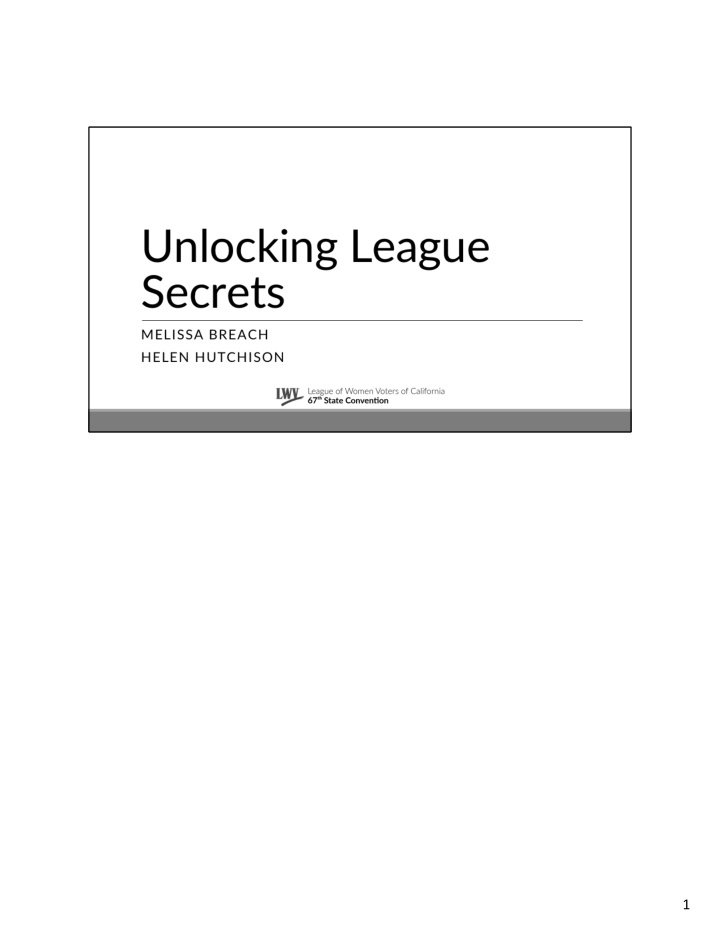



1
2
Roots of League are in women’s suffrage movement When movement succeeded, the leaders formed the League in order to ensure that women have tools to be able to be informed voters 3
Carrie Chapman Catt = suffrage leader + founder of LWV League were face of voter enfranchisement 100 years ago; we may be mainstream now, but continue to stand with those who are working to expand electorate 4
Original grassroots organization; Levels of League parallel levels of government; each level of government is separate and independent – with distinct responsibilities, but also interdependence and interactions Leagues are likewise separate separate & independent – each governed by independent board; interacts with corresponding level of government membership at local level = membership at all levels 5
League is -- and always has been – political, but nonpartisan; never support or oppose parties or candidates Definitely a political organization Spend a lot of time explaining the difference; it is who we are – happily, willingly, enthusiastically political 6
The League is all about building and strengthening community. Democracy is stronger when more of us are participating – from local community cleaning the streets up through the highest level of government Participation, building community – what we’re all about – strong, resilient communities “The League of Women Voters, a nonpartisan political organization, encourages informed and active participation in government, works to increase understanding of major public policy issues, and influences public policy through education and advocacy.” 7
We advocate on issues – what does this mean? It can be direct lobbying for changes in legislation (local, state, national), or it can be advocacy with agencies, or promotion of a particular point of view via any number of means – LTEs, policy papers, forums, media Most really effective advocacy happens in coalitions – we have guidelines for that, too. 8
We’re all about process – sometimes called “process queens” What does it mean to say we only advocate when we’ve studied an issue? League study is a very specific process 1. Define issue to be addressed – no conclusions yet! 2. Research, research, research 3. Member discussion and consensus; informed discussion based on facts 4. Adopt policy position based on member consensus 5. Start acting on that position Example: LWVC recently adopted position on Higher Ed; we are now acting on this in the legislature LWVUS recently adopted redistricting position; states all over country using it to advocate for reform in their states 9
More process? Isn’t the study process enough? Process of applying positions, analyzing proposals: make sure we really know what is being proposed, why it’s there, the background on who is supporting and opposing -- and why Deal with conflicting positions, or only partial support – in the end, it’s a board decision, but all works better when we have good info Take positions – act on them – only after we’ve made sure we know what we’re doing; not always quick, but it's where our reputation comes from 10
What we’re best known – and loved – for. Candidate forums, unbiased info on what’s on the ballot, voter registration – we do it very well, and helping others get better – Best Practices for Voter Guides being used by elections officials all over state; moving in to technology area with Voter’s Edge CA Coalitions and partners are important here also – provides entrée into other communities, helps with communication Developing material: EVG, P&C, In Depth – all require lots of people – structure, discipline, research, process – we do best when we are methodical, careful, disciplined; rely on multiple sources 11
Community ed is the neutral work – not advocacy – that is not directly related to elections It can be almost anything – forums on issues of concern, education about how to advocate for your community Like advocacy and voter service, this can be League alone, or with other organizations 12
Examples of community ed: -- basic civics ed (some Leagues work with schools, community colleges) -- community forums -- observing public bodies, publicizing what they are doing 13
Before we go to questions, I want to talk briefly about how the state League works. We are mostly volunteers, with a wonderful small staff in Sacramento. All of us who are volunteers are also active members of our local Leagues. We only function as well as we do because of the work of a lot of volunteers. How can you help? - voter service – Voters Edge for your county, and beyond. Help research and write about ballot measures: a job for people who love to communicate, and aren’t possessive of their own writing: the quality of what we produce is because of what I call the “League group edit” - advocacy: topical committees; people who analyze bills; training this summer – if interested, let me know - others: membership committee, fundraising committee, nominating committee, finance committee – all need people 14
Click on “Sign Up” – get a list of newsletters; scroll down to look at a variety of email groups – great way to share info and get questions answered 15
16
Recommend
More recommend